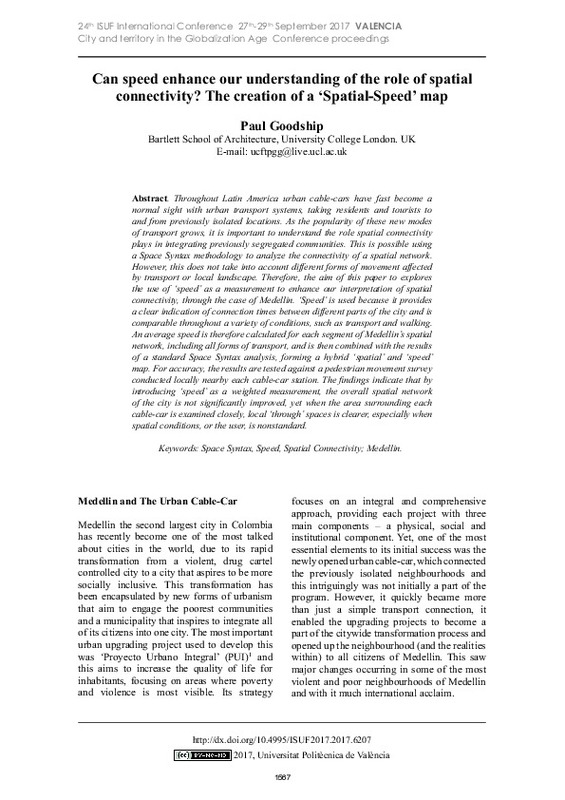JavaScript is disabled for your browser. Some features of this site may not work without it.
Buscar en RiuNet
Listar
Mi cuenta
Estadísticas
Ayuda RiuNet
Admin. UPV
Can Speed Enhance Our Understanding Of The Role Of Spatial Connectivity? The Creation Of A ‘Spatial-Speed’ Map
Mostrar el registro sencillo del ítem
Ficheros en el ítem
| dc.contributor.author | Goodship, Paul
|
es_ES |
| dc.coverage.spatial | east=-75.56457369999998; north=6.2530408; name= Medellín, Antioquia, Colòmbia | es_ES |
| dc.date.accessioned | 2018-12-18T07:48:05Z | |
| dc.date.available | 2018-12-18T07:48:05Z | |
| dc.date.issued | 2018-04-20 | |
| dc.identifier.isbn | 9788490485743 | |
| dc.identifier.uri | http://hdl.handle.net/10251/114031 | |
| dc.description.abstract | [EN] Throughout Latin America urban cable-cars have fast become a normal sight with urban transport systems, taking residents and tourists to and from previously isolated locations. As the popularity of these new modes of transport grows, it is important to understand the role spatial connectivity plays in integrating previously segregated communities. This is possible using a Space Syntax methodology to analyse the connectivity of a spatial network. However, this does not taking into account different forms of movement affected by transport or local landscape. Therefore, the aim of this paper to explores the use of ‘speed’ as a measurement to enhance our interpretation of spatial connectivity, through the case of Medellin. ‘Speed’ is used because it provides a clear indication of connection times between different parts of the city and is comparable throughout a variety of conditions, such as transport and walking. An average speed is therefore calculated for each segment of Medellin’s spatial network, including all forms of transport, and is then combined with the results of a standard Space Syntax analysis, forming a hybrid ‘spatial’ and ‘speed’ map. For accuracy, the results are tested against a pedestrian movement survey conducted locally nearby each cable-car station. The findings indicate that by introducing ‘speed’ as a weighted measurement, the overall spatial network of the city is not significantly improved, yet when the area surrounding each cable-car is examined closely, local ‘through’ spaces is clearer, especially when spatial conditions, or the user, is non-standard. | es_ES |
| dc.format.extent | 14 | es_ES |
| dc.language | Inglés | es_ES |
| dc.publisher | Editorial Universitat Politècnica de València | es_ES |
| dc.relation.ispartof | 24th ISUF International Conference. Book of Papers | es_ES |
| dc.rights | Reconocimiento - No comercial - Sin obra derivada (by-nc-nd) | es_ES |
| dc.subject | Space syntax | es_ES |
| dc.subject | Speed | es_ES |
| dc.subject | Spatial connectivity | es_ES |
| dc.subject | Medellín (Colombia) | es_ES |
| dc.title | Can Speed Enhance Our Understanding Of The Role Of Spatial Connectivity? The Creation Of A ‘Spatial-Speed’ Map | es_ES |
| dc.type | Capítulo de libro | es_ES |
| dc.type | Comunicación en congreso | es_ES |
| dc.identifier.doi | 10.4995/ISUF2017.2017.6207 | |
| dc.rights.accessRights | Abierto | es_ES |
| dc.description.bibliographicCitation | Goodship, P. (2018). Can Speed Enhance Our Understanding Of The Role Of Spatial Connectivity? The Creation Of A ‘Spatial-Speed’ Map. En 24th ISUF International Conference. Book of Papers. Editorial Universitat Politècnica de València. 1567-1580. https://doi.org/10.4995/ISUF2017.2017.6207 | es_ES |
| dc.description.accrualMethod | OCS | es_ES |
| dc.relation.conferencename | 24th ISUF 2017 - City and Territory in the Globalization Age | es_ES |
| dc.relation.conferencedate | Septiembre 27-29,2017 | es_ES |
| dc.relation.conferenceplace | Valencia, Spain | es_ES |
| dc.relation.publisherversion | http://ocs.editorial.upv.es/index.php/ISUF/ISUF2017/paper/view/6207 | es_ES |
| dc.description.upvformatpinicio | 1567 | es_ES |
| dc.description.upvformatpfin | 1580 | es_ES |
| dc.type.version | info:eu-repo/semantics/publishedVersion | es_ES |
| dc.relation.pasarela | OCS\6207 | es_ES |








